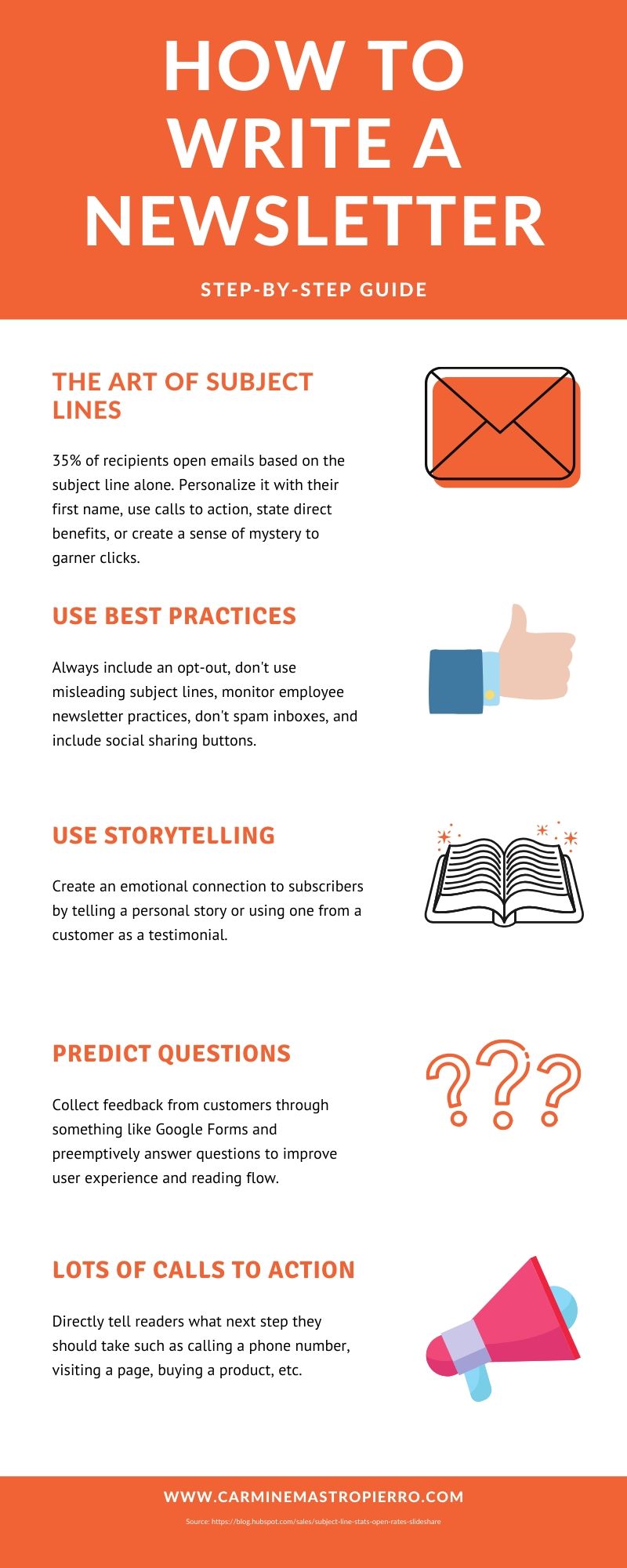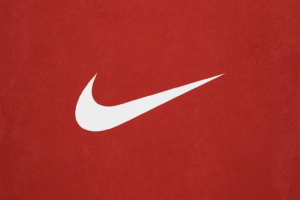So, you want to know how to write a good newsletter.
You’re in the right place.
I’ve been writing email newsletters for upwards of 8 years and have helped dozens of clients with their email campaigns.
It seems simple; it’s just a newsletter, after all, right?
Not so quick.
Copywriting is an art, and when done right, it can make you serious coin.
Heck, 82% of B2B and B2C companies use email marketing.
But, many entrepreneurs attempt writing newsletters before they’ve learned the proper strategies and the results are lackluster.
Sound familiar?
Today you’re going to learn how to write a newsletter that captivates people and makes them take action.
Take out your typewriter (not literally), and let’s get into it!
What is a newsletter?
Newsletters are printed or online reports that people can subscribe to. They contain useful pieces of content, updates, and news, as you can guess.
Companies regularly send out newsletters that share stories, information, and resources to help employees perform better.
But we’re focusing on a different type of newsletter today—a marketing newsletter. This is used to drive traffic to websites, generate sales, and grow relationships with subscribers.
This is the Friends Newsletter from Nick Gray for illustration:
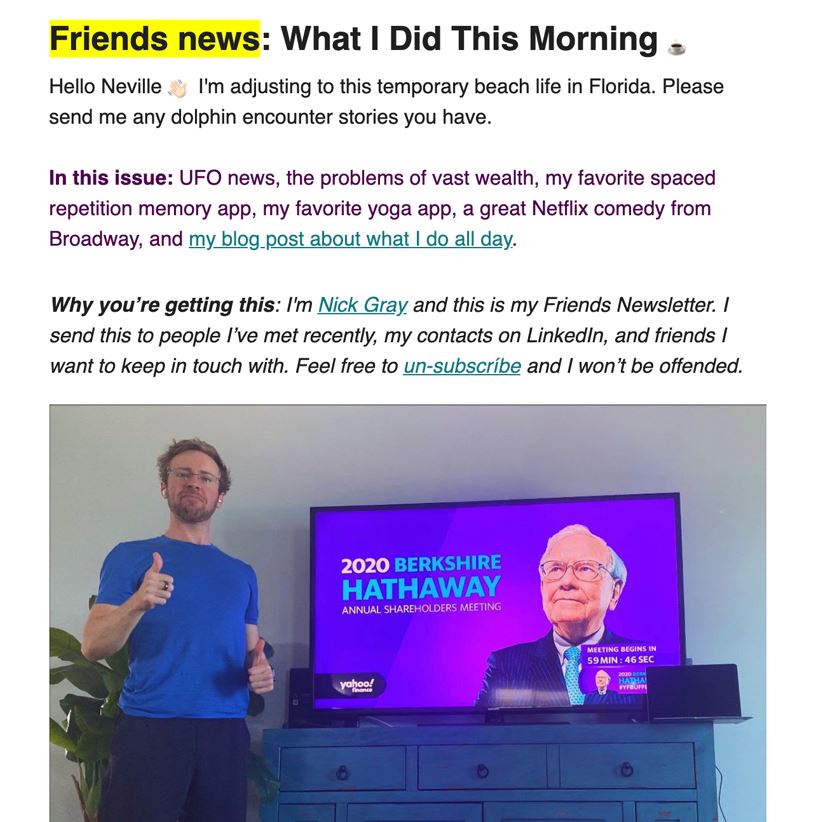
Email marketing is older than your grandma (not literally, but close) yet still drives massive ROI.
Don’t believe me?
I’ll let the data do the talking: email marketing generates $40 for every $1 spent, according to Lyfe Marketing.
I’ve also consulted with clients and helped them set up email campaigns that generate five figures in MRR.
You can learn the strategies I used in my online courses.
But without out of the way, I’m going to teach you arguably the most important component of writing newsletters next…
Newsletter subject lines
The subject line of an email will make or break your email campaigns.
If it’s boring, no one will open it.
And if no one opens it, you won’t make any money. 👎
Approximately 35% of all recipients open an email based on the subject line alone. It’s crucial that you take the time to craft one that’s irresistible to click.
One of the best newsletter subject lines to test is one that includes their name.
I’ve never experienced higher open rates with newsletter copywriting than when I use someone’s first name in the subject line.
Something as simple as “To {Name}” or “Hey {Name}” works wonders.
Why is this? Because it’s been proven that calling someone by their name enhances something known as conscious processing.
It peaks their awareness, makes them more likely to examine the information, and makes them feel emotionally attached to it—since it’s their name and identity, after all.
It also shows that you’ve done your research and you’re not just sending another copy and pasted email.
To pull this off, make sure that you require at least a first name when opting into your newsletter like MobileMonkey does on their blog:
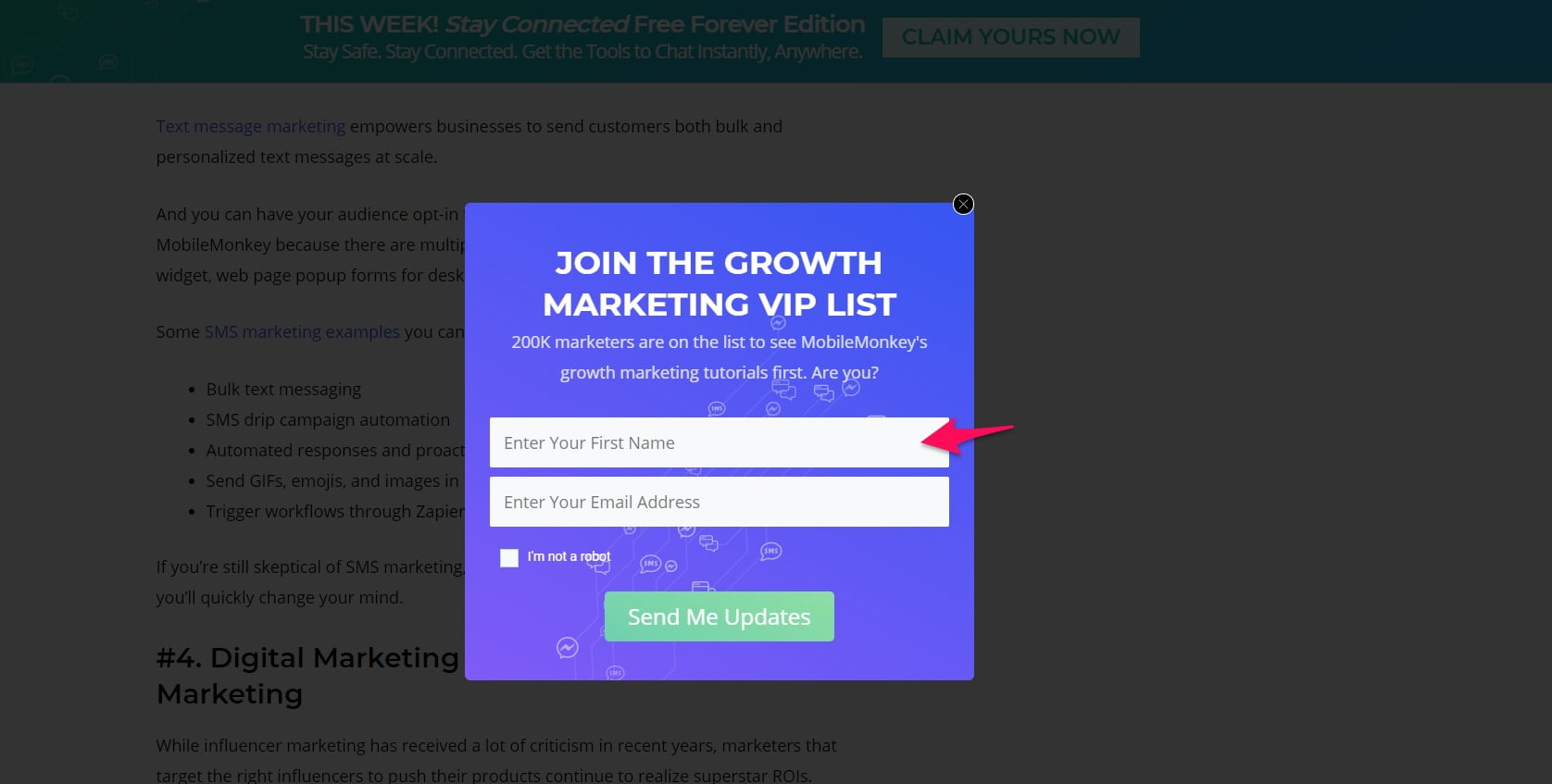
You can also use a sense of urgency or FOMO (Fear of missing out).
This will entice subscribers to open the email to avoid missing out on something great. Here are some newsletter subject line examples using this tactic:
- “12 Hours Left to Get Your Free Copywriting Course“
- “You’ll Regret Not Knowing These 5 SEO Tips“
- “John, Are You Making This Deadly Marketing Mistake?”
Look how lead pages used this strategy by simply stating, “We’re sorry:”

It instantly creates a sense of mystery.
What happened?
Is something wrong?
There are many questions that might go through your head when you hear a company you’re a customer of apologizes without context.
This no doubt greatly increased CTR as recipients would be interested to read the email.
Furthermore, I love keeping a swipe file to reference every time I’m writing a newsletter. This is simply a spreadsheet with ideas and inspiration.
When you see a headline, subject line, or any piece of copy for that matter, copy it into your swipe file. Obviously, don’t steal material from other writers, but use it for brainstorming.
I go into email marketing and lead generation more in-depth in my copywriting course if you’re interested in learning how to grow a profitable writing business.
Newsletter best practices
Now that you understand what a newsletter is and its components, let’s touch on some best practices and what to include in a newsletter.
Always include an opt-out
The Federal Trade Commission enforces a set of laws known as the CAN-SPAM Act.
This covers commercial email laws, and you absolutely need to be aware of it. Or else you might get the FBI knocking at your door.
Okay, probably not.
But, they are legitimate laws that you need to follow, and you can get into legal trouble if you break them.
Two of the rules you must follow are:
- Tell recipients how to opt out of receiving future emails from you.
- Honour opt-out requests promptly.
Any modern email service, whether it’s Mailchimp or Aweber, will provide you with an option to let subscribers opt out.
Always include this in the footer of your emails and ensure that if someone does opt out, you don’t continue emailing them. That’s when the feds will come knockin’.
If you’re enjoying today’s topic, I’d also recommend you read my email follow up guide since it contains a lot of useful information that ties in email marketing in general.
Don’t use misleading subject lines
Have you ever added “FW:” or “RE:” to an email without prior contact with that person?
If so, I have something really bad to tell you…
You’re a criminal!
The second requirement in the CAN-SPAM Act is to not use deceptive subject lines. It must accurately reflect the body of the email.
I would avoid using those prefixes in your subject lines.
Not only is it technically against the law, but it’s tricking people, and I don’t think you want to start off your relationship with a client or subscriber on that foot.
Monitor employees and team members
Do you have employees that email subscribers or prospects on your behalf?
Then you need to be monitoring that they are also following the CAN-SPAM act and general best practices.
Because guess what?
It might be someone else physically sending the emails, but it’s still coming from your address.
A.K.A, you all will get into trouble.
To avoid this, I like giving my team templates and resources to send them on the right track. Give them the link to the CAN-SPAM guidelines, email scripts, and maybe this article.
Don’t overdo it
No one wants to be spammed to death with emails every day.
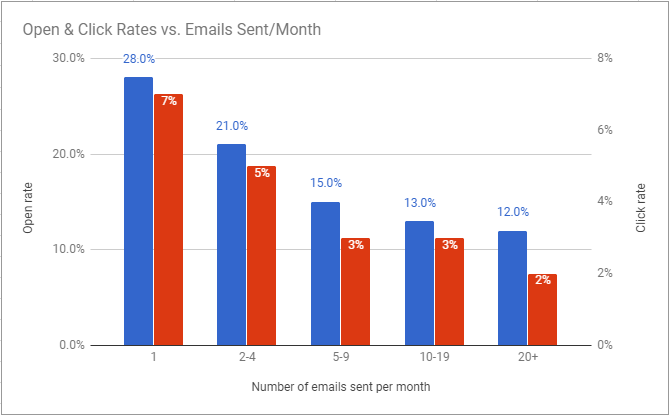
Omnisend performed a study on email frequency and it’s correlation to open rate and click-through.
They discovered that the fewer emails that were sent on a monthly basis, the higher the open rates and click-through rates became.
What can you learn from this? Quality over quantity. Don’t send out emails every day. Perhaps not even every week.
Aim for a few extremely high-quality newsletters every month.
Include social sharing
Visual content is up to 40% more likely to get shared than non-visual content.
Social sharing is the easiest way to achieve a viral effect with this in mind.
Ensure that there are Facebook and Twitter sharing links at the end of your newsletter, so subscribers can forward it to all of their friends.
On that note, if you use Facebook to promote your business, don’t miss out on my Facebook ad copy article.
Add other social networks to the newsletter if you’d like, as well.
Imagine if you had 1,000 subscribers, and 50 of them shared it. Those 50 people could reach an additional 500 users if 10 individuals per subscriber read it as a result.
Writing a newsletter – the meat and potatoes
Alright, you have a good idea of what a newsletter is, what it achieves, and how to get subscribers to click based on the subject line.
Now it’s time to learn how to write a newsletter article.
How you go about this will change depending on your individual business goals, but the principles remain the same. Here’s what you need to know:
Use storytelling to create emotional connections
Stories help subscribers emotionally relate to your business, its message, and its product.
You can get a story in three different ways: stating your own experience, sourcing someone else’s story, or crafting a fictional tale.
A personal story is effective because you can tie it into writing a newsletter article effortlessly. Let’s say that you’re promoting an e-book on affiliate marketing you recently published.
You could tell the story of how you were broke and in debt, but stumbling upon affiliate marketing changed your life. You bought a car, got an apartment, and now know the secrets to master it as a business.
That’s pretty simple, of course. But, consider your own life experiences, especially emotional ones, and how you can mention them in newsletters.
Look how Ramit Sethi talked about his experience getting married and asked for subscribers’ best piece of advice in this email:

It’s a simple illustration of how a piece of personal information can make you feel closer to the other person sending the email.
If you don’t have any stories to share, there’s nothing wrong with using someone else’s. Publications, specifically news outlets, do this every day. Everyone loves a good story, but it doesn’t have to directly be yours.
Research stories and case studies on the topic of your newsletter. If it’s about machine learning, find a story about companies that used AI to transform their productivity and output.
Lastly, you can always just make up a story.
But, be careful. Don’t claim anything outrageous, like a previous customer used your product and generated $1 billion.
People will see right through that, and they’ll lose trust in you.
Read my guide on storytelling in copywriting to learn more effective tactics.
Make it a slippery slope
The goal of the headline is to make them read the first sentence.
…The goal of the first sentence is to make them read the second sentence.
…The goal of the second sentence is to do the same as above until they finally reach a call to action.
Focus on the flow of your words. You want the subject line to intrigue them first. It should relate to their needs, wants, or pain points as a customer.
Then, the first sentence needs to be bold. Use an interesting stat, a thought-provoking question, or make an absurd comment. The goal is to hook their attention.
Traffic Think Tank executed this perfectly in one of their promotional newsletters.

Short and snappy sentences make it easy on the eyes.
Every sentence has a meaning and substance while effortlessly leading into the next.
Use the other copywriting principles in the remainder of the body, and next you know, they’re at the end of the newsletter with their credit card out.
The slippery slope method was developed by the famous copywriter Joseph Sugarman. I wrote a blog post covering some of his main tactics you can read here.
Make them feel like it’s real
Imagine selling flashy cars like Ferraris or Lamborghinis. We’ll call our company Bambino’s Autos.
We’re trying to increase how many subscribers call to schedule a test drive for some new arrivals.
How could we convince these people to come test a $500,000 car?
Simply, actually.
Just make them feel like they already own it. We could write something like this:
Everyone is staring at you. People are taking pictures. The scream of the V12 engine turns every head in sight. You’re pressed back into your seat with the slightest touch of the peddle, and the digital dash looks like something developed by NASA. Just glancing at the car gives you the jitters, let alone knowing that you own it. Test drive the new Lamborghini SVJ today.
Even if you’re not a car enthusiast, I think it’s safe to say that writing like this would make you excited to go for a test drive.
It speaks to the customer’s interest in appearing special, wealthy, and wanting to drive fast. I’m generalizing here, but follow along.
The goal is to make them imagine as if they already own the product and the experience that would come along with it.
This, as a result, generates the associated emotions and makes them more likely to take action. Cool, huh?
Predict their questions and answer them ahead of time
To make your email newsletters “slippery,” you need to be able to predict what questions and thoughts your subscribers are having. This allows you to answer them ahead of time and keep them flowing through your content.
Consider what they would want to know about pricing, features, benefits, refunds, and any other detail about what you offer. Weave this into your copy, and they will think you’re a mind reader.
More importantly, it prevented obstacles.
If someone has to stop and scratch their head or wince in suspicion, you’ve lost them.
They’re likely to click off the email and do something else—losing you the sale.
This requires you to have a solid buyer persona and a great understanding of your ideal customer.
Do you? If not, it’s something you need to develop because all great copywriting stems from it.
I recommend using a free form tool like Google Forms.
Use one of the available templates or start from scratch.
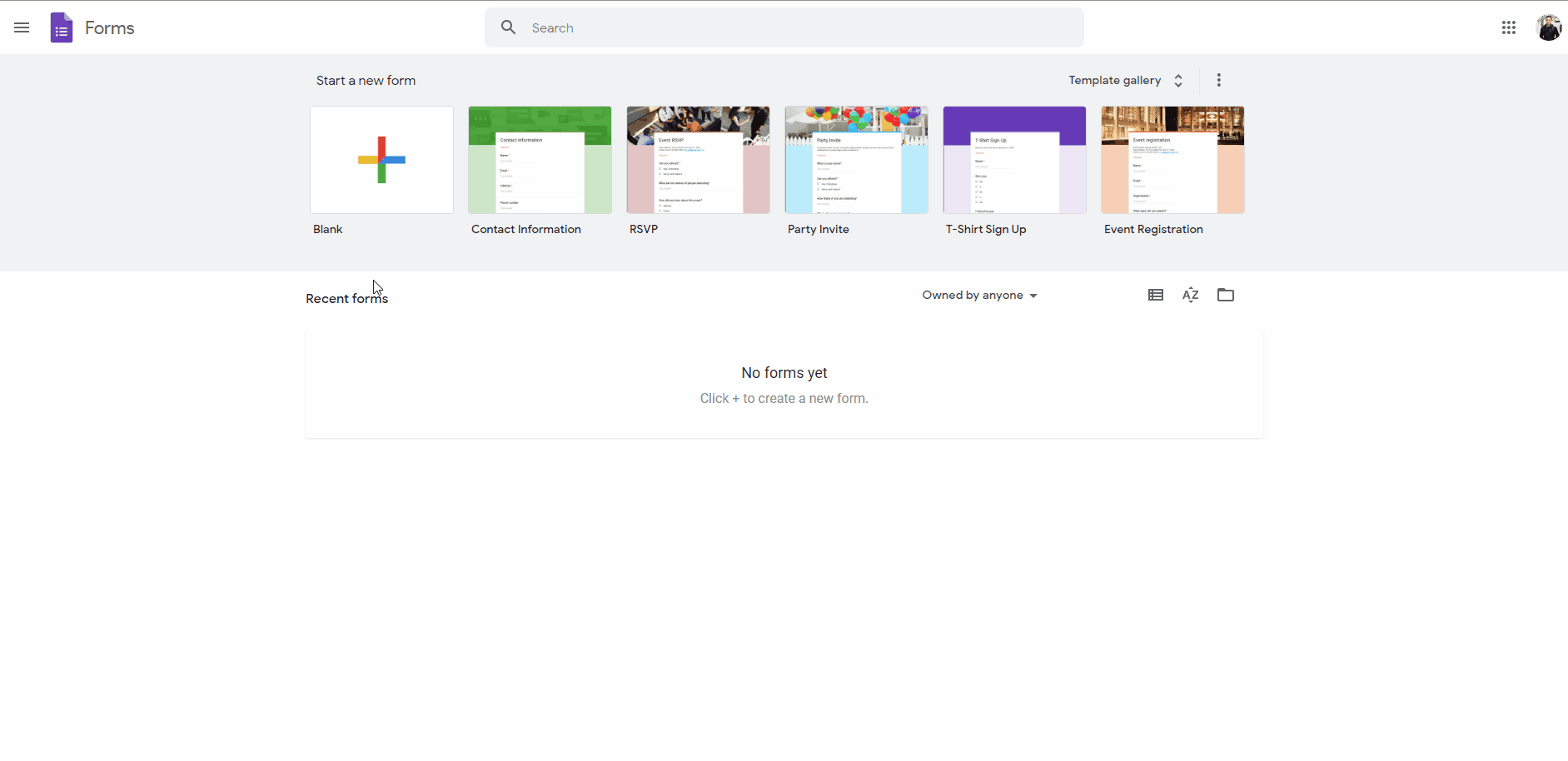
Add questions that you would like to know about customers. Good ones include:
- How much are you willing to spend on this type of product?
- What problems are you experiencing in this area?
- Why do you shop with your favourite brands?
- How did you find our business?
- Etc.

Send this out via (no pun intended) a newsletter to collect feedback.
Finish it with a call to action
A call to action is very literal.
It’s telling the reader to take some form of action that gets them closer to a sale.
In your case, it might be a discovery call, consultation, or similar.
You can’t just leave them hanging either, so the end of the newsletter needs to forward them somewhere. Examples of calls to action are:
- “Buy it now”
- “Continue reading”
- “Get our free e-book”
- “Schedule a call today”
Want to hear some crazy stats? Wordstream found that emails with calls to action lead to a 371% increase in clicks and a 1617% increase in sales.
Yep, you read that right, too.
It’s such a simple concept, but it makes so much sense, as well.
As humans, we want to be told what to do.
It makes our lives easier since it means we don’t have to think harder.
When we see a call to action, it immediately helps us move on to the next step.
Look how the retailer Huckberry did this in one of their Labor Day sale emails:
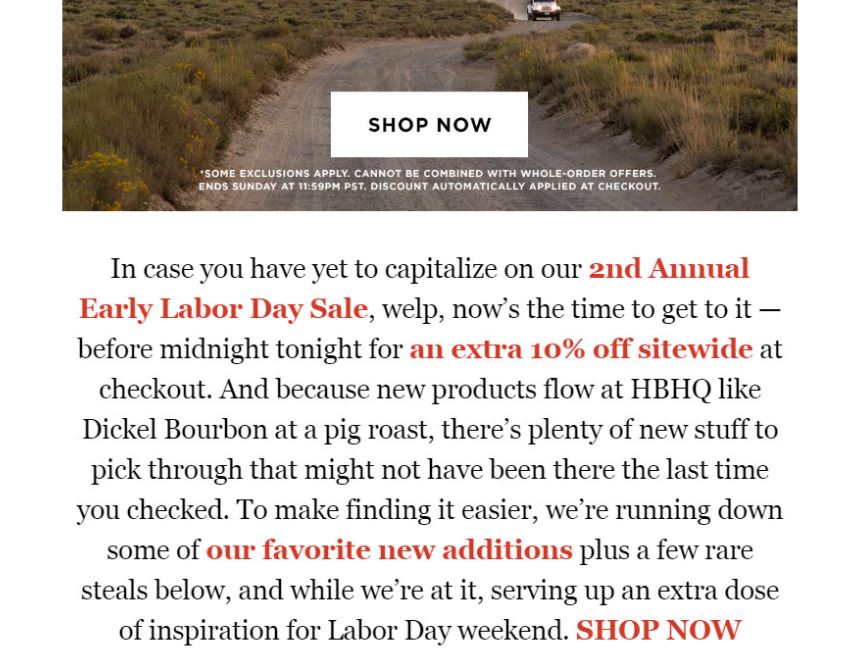
They use the “Shop Now” call to action many times throughout their newsletter to promote visiting their online store.
Best time to send email newsletters
In my cold emailing guide, I spoke about how the best time to email someone is before 9:00 AM and after 5:00 PM.
Why do you think this is?
…Because it’s before they get to work and after they’ve come home.
Your email will be one of the first things they see when they check their mailbox if you follow this strategy.
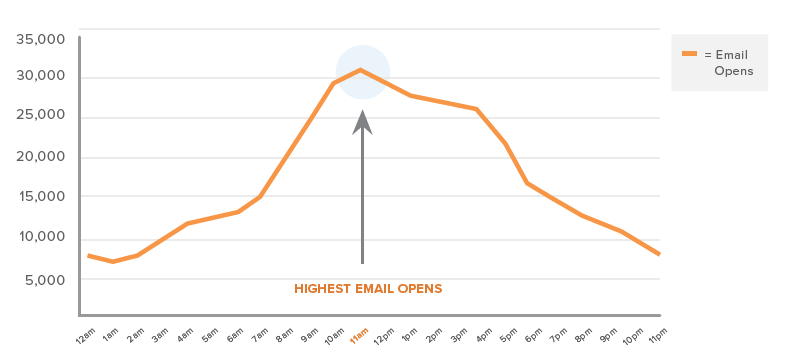
Additionally, Hubspot discovered that emails sent at 11:00 AM on Monday, Tuesday, and Wednesday experience the highest open rates.
Try it out for yourself.
Every business has a unique audience, so monitor data to see if your subscribers are different. You might notice that they open emails at 2:00 PM more, for example.
Summing up newsletter copywriting
Copywriting newsletters is a great way to reach a large audience, and collecting an email list is one of the wisest things a business owner can do.
Focus on nailing a subject line that people would want to open in the first place. Urgency and using someone’s first name is a proven tactic.
Then, take the time to craft a body of text that acts as a slippery slope. Every sentence should flow smoothly into the next and ideally will make them want to finish reading the entire newsletter.
Add in your own personal stories to make them relateable, or find one that relates. Poke their imagination with vivid detail, and answer any questions they might have before they’ve even thought of them.
If you do all of that, they’ll make it to the end of the newsletter, and you can finish it with a call to action.
Check out my copywriting courses to learn more and get mentorship from me and a community of writers.
Here’s an infographic that sums up everything I spoke about today, as well:
